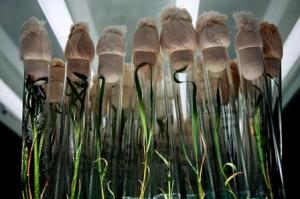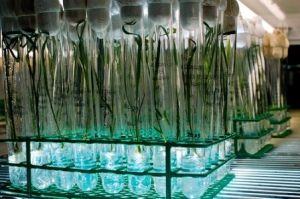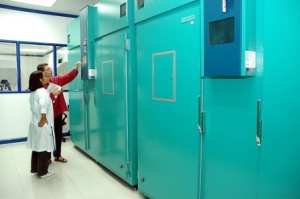CGKB News and events
In vitro bank (cultivated rice, wild rice and related genera)
Contributors to this page: T.T. Chang Genetic Resources Centre-IRRI, Philippines (Ruaraidh Hamilton, Ken McNally, Flora de Guzman, Renato Reaño, Soccie Almazan, Adelaida Alcantara, Elizabeth Naredo); WARDA, Cotonou (Ines Sánchez); UPLB-University of the Philippines at Los Baños (Teresita Borromeo).
Provides guidelines and recommendations about the best practices for the daily management of genebanks, describing when and how in vitro genebanks should be used for rice. Best practices are shown in a pale blue color with bullets. Justification for each best practice is given within brackets (…).
 Rice plants being propagated using tissue culture. (photo: IRRI) |
What is it?
In vitro culture is a useful way to conserve a portion or a whole live plant growing under an adequate artificially controlled environment. Selected parts of the plant are generally grown in sterile glass containers with selected medium (a careful combination of nutrients, vitamins, sucrose, hormones and solidifying substrate) under specific conditions of light and temperature.
Where do they exist?
In vitro banks for rice are not used at a wider scale. There are only a few worldwide, storing a limited quantity of rice samples, at the University of the Philippines at Los Baños (UPLB) and ??? (look for more information)
When should be used?
- In vitro techniques are often used when traditional techniques are not easy to implement, when accessions are difficult to main as seeds or as an alternative conservation method (that uses a controled environment, avoiding climatic changes and contamination of pest and diseases that naturaly occur in the field) for materials that are conserved as whole plants in the field. Many wild rice accessions need to be maintained in a vegetative form.
- Tissue culture techniques are also used in genebanks to ensure survival of seed lots with low viability (this happens often when new seed lots are received at a genebank for long term conservation). Check here for more information how is this done at IRRI.
- In vitro techniques are also often used for quarantine purpuses to eliminate diseases; to facilitate multiplication and distribution of vegetatively propagated materials or on molecular characterization (but these are not detailed here).
|
On this page: |
Pre-treatment
- Apply regular insecticide and fungicide treatments once and twice a month, respectively.
Collection of materials
Parts of the plant
- Use young stems or young shoots as starting material.
Time of the year
- They can be collected whole year round.
Size
- Use about 8-10 nodes, of aproximately 15cm long each.
Maturity
- Use preferably young or newly grown materials.
Special care
- Special care (disinfection of cutting tools) - dipping/soaking of scalpel/pruning shears in detergent and 95% alcohol.
Cleaning
(to reduce the contamination to less than 30%)
- Wash shoots in soap and water.
- Soak in fungicide for 5min.
- Rinse with distilled water.
- Soak/quick rinse in 70% ethanol for 1min.
- Soak in 10% commercial bleach for 10min.
- Rinse 3 times with sterile distilled water.
Starting material
- Use 1-2 nodes containing axillary buds and shoot tip of approximately 5mm size.
Visual inspection of plant materials
- Observe for insect damage, fungal/bacterial diseases and viral symptoms.
Disposal of contaminated materials
- Autoclave contaminated cultures.
Recording information during sample processing
- Passport data (accession number).
- Culture data:
- Source of explants/place of collection.
- Date of collection.
- Date of culture/inoculation.
- Culture media.
- Symptoms for diseases (presence/absence of diseases).
 |
 |
|
Growing a culture (photo: IRRI) |
Tissue cultures of Rice plants with the vitamin A genes being grown inside a light room at IRRI. (photo: IRRI) |
Routine monitoring methods
Plant quality/viability
- Observations - survival and growth.
- Frequency - monthly.
- Tests - visual observations.
- Frequency - monthly.
Bacteria contamination
- Observations - types of bacterial contaminants.
- Frequency – weekly.
- Tests – visual observations.
- Frequency – weekly.
Genetic integrity (to detect genetic changes and mixtures) (look for recommendations from other genebanks)
- Observations - ?
- Frequency - ?.
- Tests ?
- Frequency ?
Need to rejuvenate/multiplicate
- Minimum quantity/viability of stocks: the number of plants depends on the needs.
Recording information during monitoring
- Passport data (accession number).
- Culture data (source of explant/place of collection).
- Date of inoculation (date of culture/inoculation).
- Culture media.
Types of storage for in vitro banks
 Tissue culture in bottles. (photo: IRRI) |
Standard tissue culture
When should be used?
- For conservation and micro-propagation.
Sample specifications
Type of plant samples
- Use shoot tips and/or nodal cuttings.
Size of sample
- Use 6-8 bottles per accession (replicates per accession).
Type and size of container
- Use 2-4 plantlets per bottle in ampicillin bottles or vials with about 120ml.
 Scientists at IRRI checks the growth chamber for tissue culture in the Tissue Culture Laboratory. (photo: IRRI) |
Storage specifications
Growth media
- Use Murashige and Skoog (MS) macro, micro and vitamins and amino acids.
- Composition (nutrients, pH): 30g/L sucrose, 5g/L agar.
- Special components: pH = 5.7.
Culture facility regimes
- Light level/intensity: 30-50µmoles/sec provided by two 40 watt fluorescent lamps.
- Photoperiod: 8h.
- Day/night temperatures: 27-28oC/ 25-26oC.
Storage duration (time without sub culturing)
- Average - 4 months.
- Minimum and maximum range - 3-5 months.
System for tracking materials/inventory system during tissue culture storage
- Inventory of cultures every sub-culture time.
Recording information during standard tissue culture storage
- Accession data.
- Source of explant.
- Date of inoculation.
- Date/Number of subculture.
- Media.
- Culture conditions.
- Losses.
Comments
- No comments found

Leave your comments
Post comment as a guest